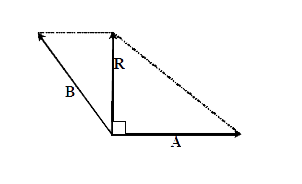The vector sum of two forces is perpendicular to their vector differences .In that case , the forces
equal to each other
equal to each other in magnitude
not equal to each other in magnitude
can not be predicted
The correct Answer is:b
→a×→band→b×→a are oppositely directed. So θ=π.
Topper's Solved these Questions
- COMPETITION CARE UNITBook:ICSEChapter:COMPETITION CARE UNITExercise:Dynamics (UNIFORMLY ACCELERATED MOTION)
Explore 58 Videos
- COMPETITION CARE UNITBook:ICSEChapter:COMPETITION CARE UNITExercise:Dynamics (PROJECTILE MOTION)
Explore 31 Videos
- COMPETITION CARE UNITBook:ICSEChapter:COMPETITION CARE UNITExercise:OBJECTIVE QUESTIONS FROM PREVIOUS IAS EXAMINATIONS
Explore 50 Videos
- CIRCULAR MOTION Book:ICSEChapter:CIRCULAR MOTION Exercise:MODULE 2 (FROM ROTATIONAL KINETIC ENERGY , WORK ,POWER)
Explore 24 Videos
- DIMENSIONSBook:ICSEChapter:DIMENSIONSExercise:SELECTED PROBLEMS (FROM CONVERSIONS OF ONE SYSTEMS OF UNITS INTO ANOTHER)
Explore 9 Videos
Similar Questions
Vector sum of two forces of 10N and 6N cannot be:
View SolutionVector sum of two forces of 10N and 6N cannot be:
View SolutionTwo forces are such that the sum of their magnitudes is 18N and their resultant is 12 N which is perpendicular to the smaller force. Then the magnitude of the forces are
View SolutionWhat is the condition for perpendicularity of two vectors ?
View SolutionThe resultant of two vectors is perpendicular to first vector of magnitude 6N. If the resultant has magnitude 6√3N, then magnitude of second vector is
View SolutionThe resultant of two vectors A and B is perpendicular to the vector A and its magnitude is equal to half the magnitude of vector B. The angle between A and B is -

View SolutionThe sum of two vectors A and B is at right angles to their difference. Then
View SolutionThe sum of two vectors A and B is at right angles to their difference. Then
View SolutionThe sum of two vectors A and B is at right angles to their difference. Then
View SolutionSum of magnitude of two forces is 20 N and magnitude of their resultant is 10 N. If resultant is perpendicular to the smaller force find values of both forces.
View Solution